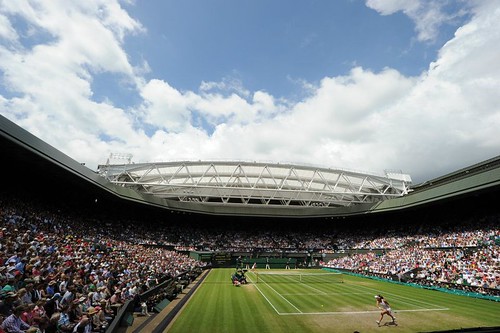24th June 2013 Lima, Peru
“If you can meet with Triumph and Disaster, and treat those two imposters just the same…”
The following is a guest post by Ben Rawlings, Prosperity Officer at the British Embassy in Lima.

That is the inspirational quote from Rudyard Kipling’s poem “If…” inscribed above the entrance to Wimbledon’s Centre Court, waiting to greet those who today will begin the battle for one of tennis’s most treasured trophies. Wimbledon is one of the most famous sporting events in the world, and for many people it is a by-word for “Englishness”: the neat grass courts, clipped British accents calling for “new balls please” or quieting the crowd, immaculately turned-out line judges and ball boys & girls, strawberries and cream, and of course rain stopping play.
Over the next two weeks nearly half a million people are expected to descend on SW1 – Wimbledon’s famous London postcode – and over 350million people will be watching around the world. The UK will be cheering on Olympic Gold medallist Andy Murray. Already ranked number 2 in the world (and UK number 1), he will be hoping to go one better than last year, where he lost in the final to Roger Federer.
Although there are no Peruvians in this year’s tournament, Peru has had a Wimbledon winner: Alejandro Olmedo, from Arequipa, who beat Rod Laver for the title in 1959 (though he played most of his career in the United States and was listed as a US player). Laura Arraya, who was born in Argentina but emigrated to Peru as a child and represented Peru in her professional career, reached the Women’s Singles Quarter Finals in 1991.
Wimbledon isn’t just a test of nerve and ability for the world’s top tennis players: it is also a major logistical operation. Around 6,000 staff will ensure the event runs smoothly – including the 250 Ball Boys and Girls recruited from schools across London, who will handle the 50,000 or so balls (stored at 20 degrees Celsius, new balls are used after the first 7 games and then after every 9 games) that will be used during the tournament.
Nearly half a million visitors need feeding, and not just the strawberries & cream and glasses of Pimm’s that Wimbledon is famous for! Last year, as well as 28,000kg of strawberries, 7,000 litres of cream and 200,000 glasses of Pimm’s, they went through 300,000 cups of tea and coffee, 190,000 sandwiches and 100,000 pints of beer and lager – making Wimbledon the largest single annual sporting catering event in Europe.
To handle the potential impact on the environment, recycling facilities allowing clean recyclables to be separated a source were introduced in 2008, boosting recycling rates from 22% to over 53%. An energy efficient Material Recovery Facility and “waste-to-energy” plant (for non-recyclables) delivers a reduction from landfill of around 95% by volume, and a water recycling plant recycles approximately 95% of all the water used. But it’s not all technology: Rufus, a harrier hawk, flies around the grounds most mornings of the championships to deter pigeons from roosting (which could affect play and cause other inconveniences for players, officials and visitors).
Wimbledon is just one example of the important role sport plays in British society, and the economy. 2012 was an outstanding year for British sport, with the Olympic and Paralympic Games showcasing not just the talent of our athletes but also the quality of our venues and our expertise in delivering major global events. As well as annual events like Wimbledon, we will soon be hosting the Rugby League World Cup, the Ryder Cup (golf), and the Commonwealth Games. For more information about the UK’s expertise in sport, visit our Sport is GREAT facebook page. For more information about Wimbledon, visit the official web page.
this was fabbbb.